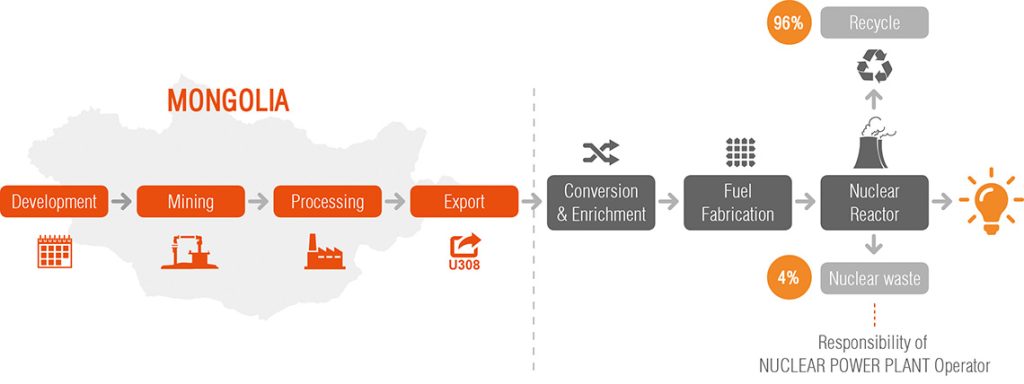uranium
natural uranium
Uranium is a common natural metal found in soil, rock and water all over the Earth. The Human body also contains between 90 and 150 micro grams of uranium.
Its natural radioactivity is the principal source of heat that prevents the Earth’s mantle from cooling. Owing to this property, uranium has become the main material used by the nuclear industry for the production of electricity.
Traces of uranium occur almost everywhere, in seawater and oceans. Uranium mines are operated in locations where it is found in large quantities.

1 gram
of uranium produces as much heat of 2.8 tons of coal
uranium ore concentrate
 Yellow cake
Yellow cakeuranium fuel cycle

uranium formation in eastern gobi, mongolia
radiation usage
Today, to benefit humankind, radiation is used for generating electricity but also in space exploration, food safety or medicine. In Mongolia, activity involving radiation occurs in six sectors, according to the Nuclear Energy Commission:

- Healthcare: X-rays are one of the most common uses of radiation. Radiation therapy uses the energy from ionizing radiation to destroy cancer cells;
- Food and agriculture: killing bacteria and viruses and sterilizing food packaging;
- Geology and mining: determining the age of geological formations;
- Education and Sciences: determining the age of historical or prehistoric artifacts;
- Environment: water and air pollution studies;
- Industry: quality control of materials, detecting the presence of various gases in the atmosphere (e.g. fire detectors).
the uranium industry – a regulated activity
Mongolian State policies support increased exploration of natural radioactive mineral resources. Their objective is to improve the quality of exploration, mining and processing activities and to develop high-tech technologies to produce valued-added products.
All “radioactive mineral resources’ deposits are classified as strategically important without regard to their size” according to the Nuclear Energy Law of Mongolia, and the Mongolian State Policy on Radioactive Mineral Resources and Nuclear Energy.
The Nuclear Energy Commission of Mongolia has signed memorandums of understanding with France, Japan, India, the Czech Republic, USA, Russia, China, Canada and South Korea for cooperation in the radioactive mineral resources sector and the nuclear energy industry to develop Mongolian expertise in the field.





